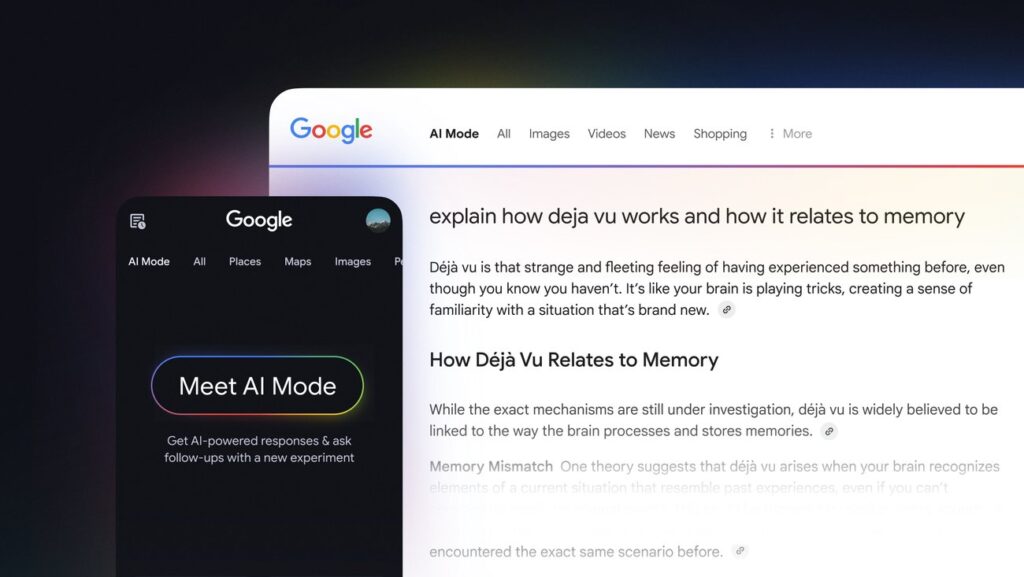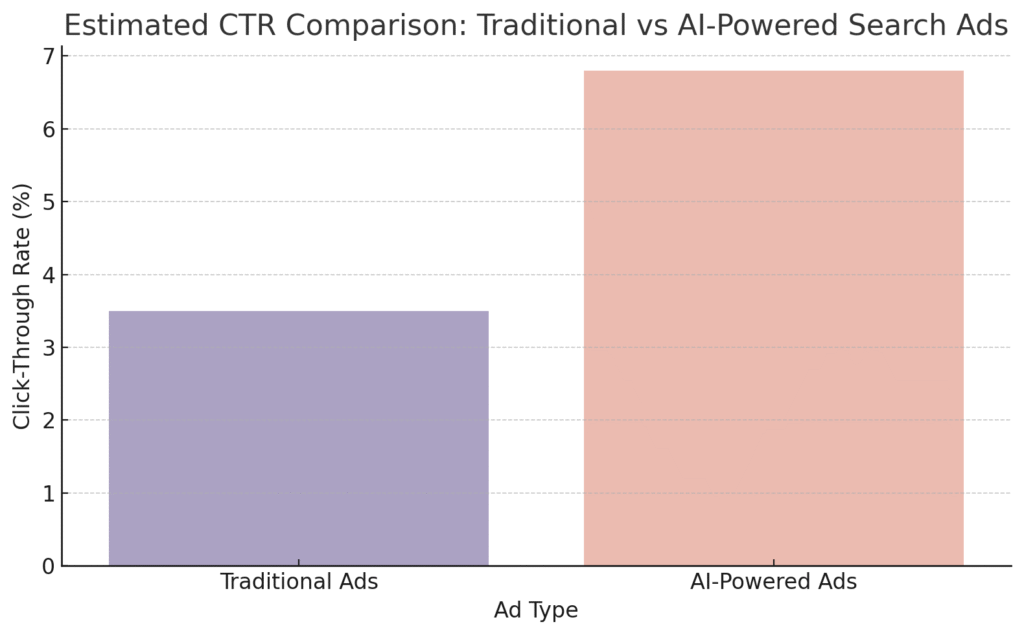By SB | Digital Marketing Decoded

Google’s AI Mode in action: answering complex queries with contextual precision, here seen explaining the phenomenon of déjà vu.
Picture this: You’re searching on Google, trying to figure out how to start a website for your homegrown pickle brand. Instead of a bunch of links, you get a full-blown AI-generated guide—and oh, look, there’s a nifty ad for Wix quietly sitting within the answer. Not in-your-face, not annoying. Just… there. Helpful. Contextual. Subtle, almost like that friend who recommends skincare while also selling it.
Welcome to the future of search—Google-style.
At Google Marketing Live 2025 (which, for the record, had the marketing world doing collective spit takes), Google announced that it’s embedding ads directly into its AI-powered search experiences. No more guessing games. If you’re asking long-winded, complex questions (which let’s be honest, we all do), you’re about to get tailored ads delivered with a side of Gemini 2.5-powered wisdom.
And if you’re a digital marketer in India? This changes everything.
Why This Matters for India
India is Google’s largest user base outside the U.S., and we’re not shy about asking Google everything from “how to boil egg in pressure cooker” to “how to scale D2C brand using Instagram and WhatsApp marketing.” With AI Overviews already pushing a 10% uptick in usage in markets like India, it’s only a matter of time before ads wrapped inside AI-generated summaries start appearing on our screens.
From SEO to SEM, this is the beginning of a new chapter—SearchGPT, powered by Gemini and bankrolled by brands.
So, What Exactly Is AI Mode?
Watch how Google’s new AI Mode transforms search into a smart conversation.
Think of AI Mode as the cooler, smarter cousin of traditional Google Search. Instead of keyword matching, it’s conversational. Ask it complex, layered questions like “how to start a fitness brand for women over 40 in tier 2 cities”—and it won’t blink. It’ll break that down into multiple subtopics and give you a thorough, multimodal response.
Thanks to a custom version of Gemini 2.5, this system doesn’t just search. It thinks. And starting in the U.S., it also sells.
The Ad Magic: How It Works
Here’s a look at how Google’s AI-powered search interface responds to real queries—complete with subtle, smart ad placements.
Instead of banner blindness and annoying pop-ups, Google’s ad strategy here is… elegant. It’s integrated directly into the AI-generated response.
Let’s say you ask:
“How to build a Shopify-like ecommerce site without coding?”
Your result might be a neat AI response explaining platforms, steps, timelines—and right there—an ad for Shopify, Webflow, or even a desi alternative like Dukaan or Instamojo.
Contextual. Relevant. And clearly labeled “Sponsored”, just in case the FTC is watching.
If you’re wondering how this new model compares to the good ol’ keyword-chasing, banner-slinging days—here’s a breakdown that spells out the shift.
| Aspect | Traditional Search Ads | AI-Powered Search Ads (AI Mode/Overviews) |
| Ad Placement Style | Banner/Text above or beside results | Embedded contextually within AI answers |
| User Intent Matching | Keyword-based | Intent/context-based using longer queries |
| Interaction Type | One-click/static | Conversational/follow-up enabled |
| Ad Visibility | High but sometimes ignored (ad blindness) | Subtle, contextually relevant |
| Targeting Basis | Exact/Phrase/Broad keyword match | Query expansion + semantic signals |
| CTR Potential | Moderate | High (context-driven engagement) |
| SEO Impact | Can compete with organic SEO | Displaces SEO with AI-generated summaries |
| Cost Efficiency | Varies by CPC bidding | Potentially better if well-placed |
With AI Mode, it’s less about exact-match keywords and more about meeting user intent mid-conversation.
And if you’re still wondering why marketers are scrambling to understand AI Mode, here’s a glimpse into the performance story:

AI-powered search ads aren’t just smarter—they’re driving higher engagement, too.
But Wait… What About SEO?
Ah yes, the holy grail of Indian digital marketing.
With AI Overviews becoming the default for high-intent queries, traditional SEO may feel a bit sidelined. If users get answers directly from Google’s AI, what’s the incentive to click through to your blog?
This is where marketers need to pivot. Less keyword stuffing, more brand positioning. Think: How can your product be part of the answer rather than just hoping to rank for it?
Enter AI Max for Search
AI Max for Search is Google’s new advertising beast—designed for context, not just clicks.
For Indian brands, especially SMEs, this is gold. Your Performance Max, Shopping, and Broad Match campaigns could now show up inside AI Mode and AI Overviews without you even knowing. If that scares you, good. It’s time to understand how automation eats ad targeting for breakfast.
Case in point: Campaigns using Broad Match keywords have seen conversion jumps of up to 27%. And the AI even figures out when not to show your ad, which is pretty much every budget-conscious Indian marketer’s dream.
And The Elephant in the Room: Publisher Panic
Let’s address the fallout. Media houses, publishers, bloggers—they’re all crying foul. The News/Media Alliance called it theft, accusing Google of lifting content without sharing traffic or revenue.
And here’s the kicker: If you don’t want your content in Google AI results, your only option is to opt out of Google Search entirely. That’s like asking a D2C brand to quit Instagram.
So yeah, it’s complicated.
What Does This Mean for Indian Advertisers?
For one, more inventory. Ads are now going to appear in:
- AI Mode (text + visual + follow-up questions)
- AI Overviews (mobile + desktop)
- Deep Search responses (aka research reports in seconds)
- Visual search tools (yes, even your phone camera gets ads now)
All backed by Google’s Shopping Graph—a database of over 50 billion listings.
If you’re an Indian brand selling sarees, keto snacks, or online yoga classes, you better believe this will affect how your products get discovered.
Consumers: Excited or Exhausted?
A recent survey showed that 36% of users are wary of AI-powered ads. They worry it’s manipulative, hard to distinguish, or just too much.
That means trust and transparency will be huge. Especially in India, where WhatsApp forwards still carry more weight than some news sites. Brands need to tread carefully.
Competitive FOMO Is Real
Google is not alone.
- Perplexity started placing ads in late 2024.
- Meta is using public content for AI training.
- OpenAI might bring ads to ChatGPT.
If you’re not preparing for ad integrations in AI interfaces, you’re playing catch-up.
What India Needs to Watch
- Policy & Privacy: With India’s Digital Personal Data Protection Act (DPDP) coming into effect, how will AI-driven targeting hold up?
- Language Diversity: Google plans to expand AI Overviews to over 40 languages. Will regional brands get equal ad opportunities in Hindi, Bengali, Tamil, Telugu?
- Infrastructure: Can Indian marketers adapt to real-time ad adjustments in a landscape that changes every time you blink?
Final Word (For Now)
Google’s AI-Ad fusion isn’t just another update. It’s a complete rewiring of how we search, advertise, and connect with audiences.
For digital marketers in India, it means rewriting playbooks, upskilling in AI-driven platforms, and getting cozy with Gemini. No more treating AI as a “future trend.” It’s here, it’s monetized, and it’s changing the rules.
So ask yourself—are your campaigns ready to show up in the answer?
Credits: See full citations list for linked sources.
SB is a digital marketer who spends her weekends decoding AI trends, debating skincare labels, and explaining to her daughter why YouTube Shorts isn’t homework.
